Blastoff of SpaceX Falcon 9 rocket from Cape Canaveral Air Force Station in Florida on April 18, 2014. Credit: Alan Walters/AmericaSpace
Story updated[/caption]
The powerful SpaceX Falcon 9 rocket that launched successfully on a cargo delivery run for NASA bound for the Space Station on Friday, April 18, from Cape Canaveral, Fla, also had a key secondary objective for the company aimed at experimenting with eventually recovering the rockets first stage via the use of landing legs and leading to the boosters refurbishment and reuse further down the road.
Marking a first of its kind test, this 20 story tall commercial Falcon 9 rocket was equipped with a quartet of landing legs to test controlled soft landing techniques first in the ocean and then back on solid ground at some later date this year or next – by reigniting the 1st stage engines for a guided touchdown.
The 12 foot diameter Falcon 9 rocket would sprout the legs just prior to water impact for the controlled soft landing in the Atlantic Ocean, guided by SpaceX engineers.
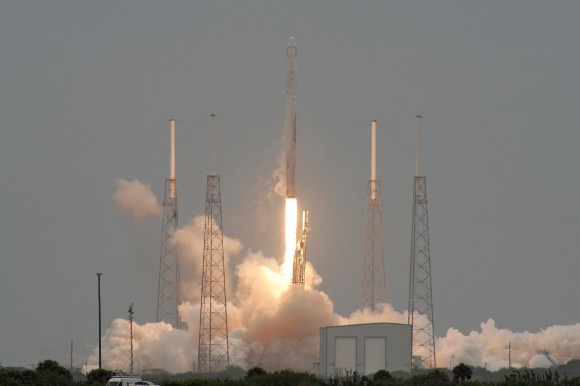
Prior to the launch SpaceX managers were careful not to raise expectations.
“The entire recovery of the first stage is completely experimental,” said Hans Koenigsmann, SpaceX vice president of mission assurance. “It has nothing to do with the primary mission.”
He estimated the odds of successfully retrieving an intact booster at merely 30 or 40 percent.
Following Friday’s blastoff, SpaceX reported they made significant strides towards that goal of a 1st stage recovery.
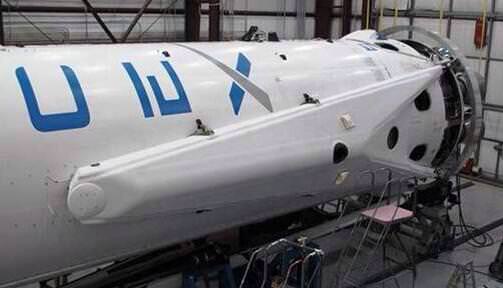
SpaceX engineers had preprogrammed the spent first stage to relight several Merlin 1 D engines after completing the boost phase and stage seperation to stabilize it, reduce its roll rate and then gradually lower its altitude back down to the Atlantic Ocean’s surface for a soft landing attempt and later possible recovery by retrieval ships.
All these critical steps seemed to go fairly well in initial reports that are subject to change.
SpaceX CEO and founder Elon Musk reported at a post launch briefing and later tweeted further updates that the Falcon 9 first stage actually made a good water landing despite rough seas, with waves swelling at least six feet.
“Roll rate close to zero (v important!).”
“Data upload from tracking plane shows landing in Atlantic was good! Several boats enroute through heavy seas,” Musk tweeted.
Furthermore he reported that the 1st stage survived the ocean touchdown.
“Flight computers continued transmitting for 8 seconds after reaching the water. Stopped when booster went horizontal.”
Because of the high waves, the recovery boats had difficulty reaching the booster in the recovery area located some two hundred miles off shore from Cape Canaveral.
Several previous attempts by SpaceX to recover the first stage via parachutes and thrusters were not successful. So SpaceX adopted this new approach with the landing legs and 1st stage Merlin 1 D engines.
Further details will be proved when they become available.
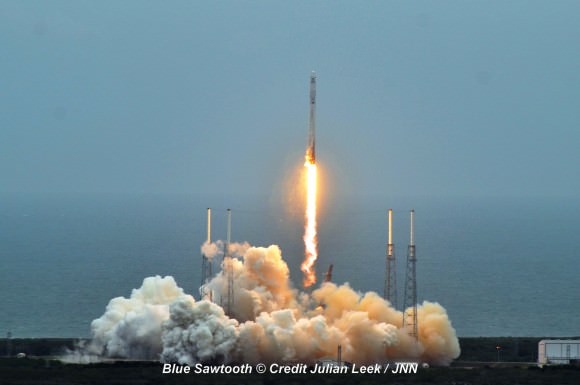
The attachment of the 25 foot long 1st stage landing legs to SpaceX’s next-generation Falcon 9 rocket for ocean recovery counts as a major step towards the firm’s future goal of building a fully reusable rocket and dramatically lowering launch costs compared to expendable boosters.
The eventual goal is to accomplish a successful first stage touchdown by the landing legs on solid ground back somewhere near on Cape Canaveral, Florida.
Musk said that SpaceX is still working out the details on finding a suitable landing location with NASA and the US Air Force.
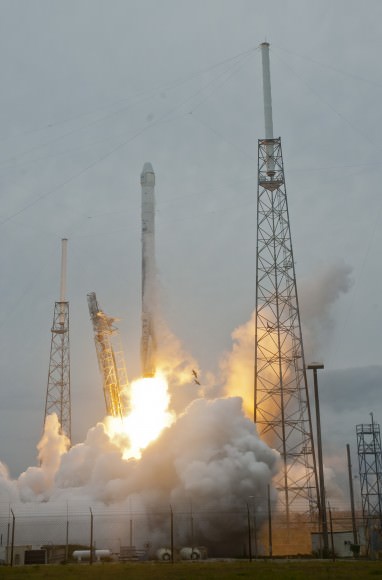
Extensive work and testing remains to develop and refine the technology before a land landing will be attempted by the company, says Musk.
It will be left to future missions to accomplish a successful first stage touchdown by the landing legs back on solid ground back through a series of ramped up rocket tests at Cape Canaveral, Florida.
“Even though we probably won’t get the stage back, I think we’re really starting to connect the dots of what’s needed,” Musk said at the briefing.
“There are only a few more dots that need to be there to have it all work. I think we’ve got a decent chance of bringing a stage back this year, which would be wonderful.”
Overall Musk was very pleased with the performance of the rocket and the landing leg test.
“I would consider it a success in the sense that we were able to control the boost stage to a zero roll rate, which is previously what has destroyed the stage, an uncontrolled roll, where the on-board nitrogen thrusters weren’t able to control the aerodynamic torque and spun up.”
“This time, with more powerful thrusters and more nitrogen propellant, we were able to null the roll rates.”
“I’m feeling pretty excited,” Musk stated. “This is a happy day. Most important of all is that we did a good job for NASA.”
This extra powerful new version of the Falcon 9 dubbed v1.1 is powered by a cluster of nine of SpaceX’s new Merlin 1D engines that are about 50% more powerful compared to the standard Merlin 1C engines. The nine Merlin 1D engines 1.3 million pounds of thrust at sea level rises to 1.5 million pounds as the rocket climbs to orbit.
Therefore the upgraded Falcon 9 can boost a much heavier cargo load to the ISS, low Earth orbit, geostationary orbit and beyond.
Indeed Dragon is loaded with nearly 5000 pounds of cargo, about double the weight carried previously.
If all goes well, Dragon will reach the ISS early on Easter Sunday morning after a two day orbital chase.
Station crew members Rick Mastracchio and Steven Swanson will grapple the Dragon cargo freighter with the 57 foot long Canadarm2 on Easter Sunday at about 7:14 a.m. and then berth it at the Earth-facing port of the Harmony module.
NASA TV coverage of the Easter Sunday grappling process will begin at 5:45 a.m. with berthing coverage beginning at 9:30 a.m. : http://www.nasa.gov/ntv
Stay tuned here for Ken’s continuing SpaceX, Orbital Sciences, commercial space, Orion, Chang’e-3, LADEE, Mars rover, MAVEN, MOM and more planetary and human spaceflight news.
Ken Kremer
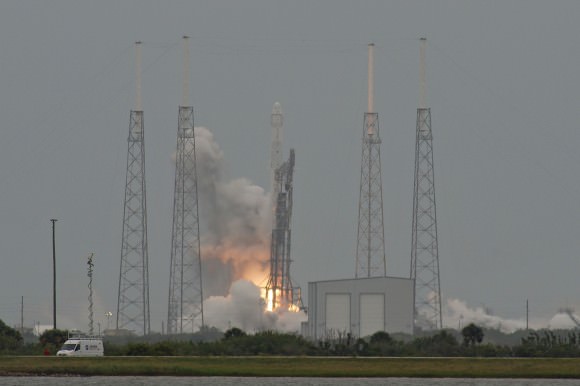

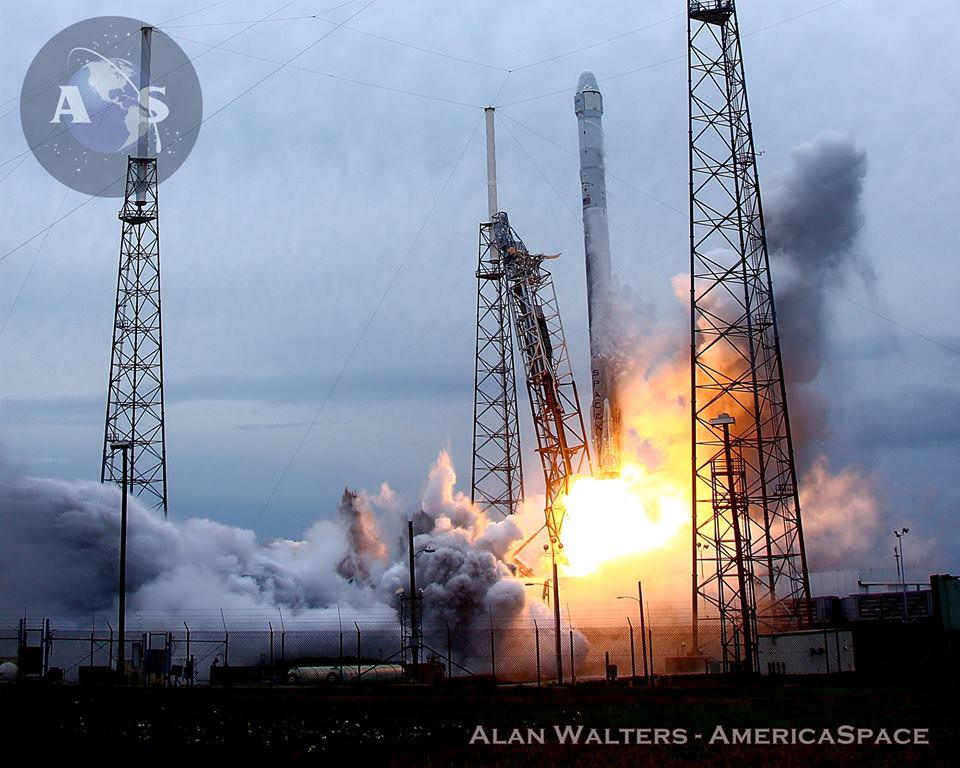
Absolutely splendid news, I can’t wait to see the first stage land on land.
What I don’t get is this. SpaceX is all worked up about reusable rockets like nothing else would make sense but barely anybody else seems to be coming to the same conclusion. They can’t all be right, so who’s missing what here. But the news is great any way you cut it. Congratulations SpaceX.
Kind regards,
hydrazine.
SpaceX is not at odds with the other players, it is simply very far ahead of them. The economics are simply overwhelming, would you buy a car if it came with one tank of gas and that was it?
Since the cost of fuel is around just 2-3% of the rocket, a reusable rocket could save huge dollars even figuring some serious refurbishment and quality assurance testing cost$ between launches. No throw away launch company could compete even allowing for the fact that 2 rockets the same “thrust” the reusable one delivers a fraction less payload to orbit each flight because of the reusable fuel and landing gear weight penalties.
First of all, SpaceX is way ahead of everybody else. look at Orbital Sciences, they’re using russian engines from the seventees.
Secondly, Elon Musk is known for his pioneering ideas (Tesla, Paypal) and a reusable first stage would seriously reduce launch costs (currently ~10 000$/kg) and help them towards bigger projects such as mars.
Chickstick, I am big fan of SpaceX. SpaceX hasn’t done anything new they have just implemented established technology better and cheaper then anyone else so far. You’re also most likely driving a car with an internal combustion engine first developed in the early 1800’s. The Merlin engines on the Falcon 9 are basically the same as what was used on Apollo.
If something works then it works. SpaceX is trying to evolve existing technology but the technology itself it not revolutionary. I love this approach because it moves us forward. Waiting on a new revolutionary technology break through stop progress and you always seem to be waiting for the break through before you start moving forward again.
The Merlin engines were built from scratch and the 1Ds currently have the best thrust to weight ratio of any rocket on Earth, they are completely devolved and built in America, and cost only about $300-500 million to develop from a blank sheet. A
Oh, and the Falcon family costs at least four times less than the ULA equivalent, and the ULA basically just buys Russian tech and strings it together.
Note: The Merlin 1D has the best thrust to weight ratio of any non-staged combustion engine. All American made engines are of this subcategory, but the Russians have had some far more advanced staged combustion engines for decades***. SpaceX’s next new engine design (the Raptor) will be a staged combustion methane fueled engine. Far more efficient.
***(American rocket engine development really stalled out after Apollo due to the massive funding cuts of the Nixon administration. New engine development has never truly started back up again. They occasionally redesign an old engine, but that’s it. Other than that everyone just purchases Russian engines. They’re just… better. Mostly because they have 2 decades of additional R&D over and above anything the US has put out. SpaceX excluded, of course).
https://en.wikipedia.org/wiki/Staged_combustion_cycle_%28rocket%29
The SSMEs were of course an early example of staged combustion engines as well. Forgot about those. So I guess their have been American staged combustion engines. Just not many, and not built upon properly.
I think it was because the Air Force was one of the funders of the shuttle. They needed the shuttle to be able to land at widely separated destinations — something that a spaceship on a ballistic reentry cannot do.
Of course, Elan Musk, starting with a first principles calculation, quickly realized that building a vehicle that is strong enough to withstand 3 g’s standing on its tail and 12 g’s laying on its belly would be heavier than one that only had to withstand acceleration on one axis. So one that could land on its tail would be lighter than the original shuttle.
So the honorable Mr. Musk set about teaching a rocket to land on its tail, now that he has made the task easier by doing away with the idea taking off like a rocket and landing like an airplane.
Everyone else was discouraged by the shuttle and Burin. But several companies are trying right now anyway. And several others offered to, but refused to go ahead unless NASA or the US military directly funded the programs.
Right now though, Boeing (X-37), SpaceX (Dragon, Falcon 9R), Sierra Nevada Corporation (Dream Chaser), and Blue Origin (largely unknown) are all working on various components for reusable spacecraft or rockets. Several other companies are working on individual components.
So it isn’t that no one is working on a fully reusable rocket/spacecraft, it’s that only two companies are working on the complete package (from rocket to orbiter), by themselves: SpaceX and Blue Origin. Everyone else is working on a single piece of the puzzle, or even a single part for a single piece of the puzzle.
Reason: it’s expensive and difficult.
NASA has also expressed a desire to work on reusable rockets and spacecraft, but every time they start a project it quickly gets cancelled by your friendly neighborhood congresscritter.
Good points, gopher65. We should probably include air launch systems in that list of developing re-usability technologies. Orbital’s been doing this for quite a while and their Stratolaunch system will be a big step up. It will use a huge aircraft (White-Knight-Two-On-Steroids) as the re-usable first stage for launching intermediate loads to LEO.
However great the savings of a re-usable first stage, I doubt that anyone is going to put a $100 million satellite on top of a ‘used’ first stage, at least until there is a lengthy track record. But it makes sense in the long run for boosting lower value loads such as construction materials or supplies for an orbiting depot.
NASA reusable rocket project facts.
DC-X was taken over from BMDO by NASA. They crashed the prototype and NASA made no moves to continue it. No NASA interest of substance.
X-33 SSTO was a boondoggle. It was a hydrogen fueled vehicle with nearly negative margin for weight whose fuel tanks proved impossible to fabricate among other design impossibilities. Abandoned when it did not/could not work after pissing away a billion dollars. Design/program failure.
The cancelled Constellation program was not re-useable, nor is the SLS boondoggle which will cost several billion dollars per launch. Fiasco.
I don’t know of a single instance where NASA “started a reusable rocket project” and congress cancelled it.
NASA fundamentally isn’t really in the business of developing vehicles. Their purpose is to design and complete scientific exploration missions. Forward-thinking vehicle design directly within NASA is a political near-impossibility.
gopher65, you assume what your congress person wants and what people who are actually interested in doing something in space besides going around in circles in LEO are one in the same.
Congress people want to get elected or reelected to office. They want to keep their jobs. If you’re a congress person in a traditional “space state”, you want jobs (ie taxpayer money) directed to your state. This is how a $500 million mobile launch tower for the cancelled Constellation Program gets built. The congress people from Florida would tell you “off the record” they wish it cost $1 billion because jobs = happy voters. Also, campaign funds from the contractors who benefit from the NASA contracts. This is how congress people get elected.
Why would a congressperson want to support a cheaper way to do anything if it means a loss of jobs from his state? While the congressperson will say we need to reduce spending they really mean other states need to reduce their spending but if he can get more federal dollars into his state that is a different story.
So if you think any congress person from Florida will support spending on reusable rockets that will direct billions out of Florida into a California company that can do the same thing for a fraction of the cost, I have a bridge to sell you. You don’t need to be a rocket scientist to figure it out.
It is only private space companies that have a bottom line who will be driven to reduce costs. Elon Musk would fire any idiot employee who suggested he spend $500 million on a mobile launch tower.
NASA has also expressed a desire to work on reusable rockets and spacecraft, but every time they start a project it quickly gets cancelled by your friendly neighborhood congresscritter.
====== ==
In the 40+ years and $500 billion blown on US manned space since Apollo, Nasa has screwed up everything it touched…
Nasa promised a $7 million/launch ‘clean, safe, reliable access to space’ shuttle… then delivered a $1.6 billion/launch boondoggle which killed 2 crews and had chronic and multi-year service outages…. Nasa’s shuttle was the most unaffordable, dangerous, unreliable space vehicle in history…
The Nasa’s $8 billion ‘space station’ turned into the useless $200 billion ISS…
And while Nasa was screwing up the $20 billion failed/cancelled Constellation, private enterprise SpaceX produced vastly superior boosters/capsules for less than $500 million….
Yet rather than leverage the advanced/efficient SpaceX boosters/capsules, bloated, pork driven Nasa wastes $100 billion and a decade more on it’s next incompetent boondoggle, the unneeded, unaffordable, unsustainable shameless earmarked pork SLS/Orion….
We were fools to ever trust our Federal Govt and nasa with the US space program.
I submit that we are fools to trust the federal government, period.
If you look at NASA’s originally proposals for that “7 million a launch shuttle” (more like 50 million in today’s dollars), it has far more in common with a SNC Dreamchaser or a Boeing X-37C than it does the military-influenced shuttle that we actually got. And the Dreamchaser might well actually end up costing ~50 million a launch, depending on the rocket used to lob it into orbit. So NASA wasn’t talking out of their asses with those estimates.
There are a couple good reasons why the shuttle ended up being such a failure. 1) Too many cooks in the kitchen, and 2) too much political interference. NASA would never had designed something that looked like the shuttle on their own. It was simply not a practical design for them.
total nonsense from beginning to end. take you stuff elsewhere and dont post your anonymous coward nonsense here anymore
Naysayers are always look for someone to blame, usually in the wrong places. After all is said and done, NASA has performed remarkably well considering the political shenanigan’s operating in the background. I just wish there was a way to REMOVE those political influences from space exploration, education and science so that we might eventually reach our full potential!
i kind of flinched at the sight of a plume of black exhaust at the moment of ignition of the 1st stage. the plume went straight up the body of the Falcon, staining its immaculate white finish before it lifted off. glad the recovery experiment went according to plan. time to man-rate that Dragon 🙂
You are correct. Sadly, NASA has made human safety such a big priority one issue that human rating NASA style will take years and $$$.
NASA has made human safety such a big priority
=====
Nasa’s shuttle had extended periods during launch and reentry with no recovery from single point failure….killed 2 crews (14 souls) making it easily the most dangerous space vehicle in history.. at a bankrupting $1.6 billion/launch….
Despite spending $500 billion on US manned space in the 40+ years since Apollo ended, Nasa has not gotten a single American beyond low earth orbit, and finds itself incompetent/incapable of crewing or even resupplying our own space station…No one now working at Nasa has ever designed a successful rocket, or flown/managed a single deep space mission…
Bloated, pork driven, incompetent nasa giving safety lessons is like the Captain of the Titanic giving ship handling lessons..
We should downsize Nasa back to NACA levels, and instead use the NSF to fund enterprises like SpaceX directly.
Congress is delaying the man rating and funding for Dragon to allow the SLS and Orion to fly first thus they can kill the funding for commercial space companies like SpaceX as redundant and unnecessary to launch crew. It has been obvious from the start SpaceX and the New Commercial companies have no real friends in congress.
So happy for SpaceX they actually fulfilled their secondary objective! Looking forward to them reusing a stage sometime later this or next year!
Ken Kremer, thank you for a great follow up article. I look forward to more.
you’re welcome. thanks
Don’t worry, my friends. Even if the fed’s completely cut off funding to SpaceX, their launch manifest is rapidly ballooning. While it would be quicker with federal assistance, SpaceX will most certainly be able to continue making a growing profit and, therefore, continue their development of the F9-R. After his first successful launch, when NASA called Musk and offered his company a contract, things were pretty much set in concrete. Thanks for the initial funding NASA! You got SpaceX “off the ground”. (Pun intended.) Capitalism will take it from here.
Oh, and a second point. NASA will have pretty much no choice but to pay SpaceX for crewed missions to the ISS. Most importantly, it’ll be radically cheaper than paying Russia. And almost as important, we won’t be paying Russia.
I see NASA’s role in pioneering technology and then assisting companies like SpaceX through the Commercial program as a great synergy between government and industry. I am not a big pro govt person but in this program, we were well served. Ball is in SpaceX’s court now. Unless NASA goes all bureaucratic on us SpaceX will be flying people to ISS for under half the price of Soyuz flights while turning a nice profit to fuel R&D.
Anyone knows what the downrange distance when the first stage was separated?
vraeleragon, per Ken’s article above,”… the booster in the recovery area located some two hundred miles off shore from Cape Canaveral.”
Not exactly what you asked for, but reasonably close I’d assume.